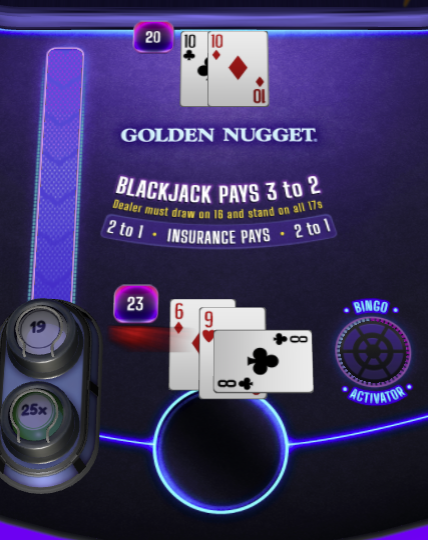As a quick summary you pay an extra 20% and the game will show you a random target (12 thru 21) and a bonus miltiplier (2x thru 100x). These enhanced odds will be paid to any hand (including splits and doubles) which wins with the matching total.
This affects your basic strategy as sometimes you stand on a lower value or hit towards a higher target. Similarly you tend to make more splits, especially for a high multiplier.
I believe a 100x multiplier appears with a probability of less than 0.001 and possibly less than 0.0005. I am in the process of reviewing my play logs to estimate the variance (insanely high). It will be harder to get the multiplier frequency from the play logs, but I may be able to do it by opening each game-details link. The multipliers are recorded for each hand.
(a) 12-15 x2 vs A - Hit
(b) 12 x2 vs 7 - Hit
(c) AA x2 - always split
(d) AA x5 vs A/7/8 - split
Looking at higher targets you tend to split most pairs but there are many exceptions to learn.
S=Stand H=Hit D=Double X=Split (V+)=on 5x or more (X+)=on 10x or more (G+)=on 25x or more (L+)=on 50x or more (C+)=on 100x.
Most decisions stay fixed or flip, but some vary e.g. soft 9 vs A (st, h, d/h, h, h, h).
2 | 3 | 4 | 5 | 6 | 7 | 8 | 9 | T | A | |
20 | S(G+)DH | S(G+)DH | S(G+)DH | S(G+)DH | S(G+)DH | S(G+)DH | S(G+)DH | S(G+)DH | S(G+)DH | S(G+)DH |
19 | S(G+)DH | S(G+)DH | S(G+)DH | S(G+)DH | S(G+)DH | S(G+)DH | S(G+)DH | S(G+)DH | S(G+)DH | S(G+)DH |
18 | S(G+)DH | S(G+)DH | S(G+)DH | S(G+)DH | S(G+)DH | S(G+)DH | S,DS,DH | S(X+)DH | S(X+)DH | S(X+)DH |
17 | S(X+)DH | S(X+)DH | S(X+)DH | S(X+)DH | S(X+)DH | S(X+)DH | S,H,DH | S,H,DH | S,H,DH | S,H,DH |
16 | S,H,DH | S,H,DH | S,H,DH | S(X+)DH | S,H,DH | H(X+)DH | H(X+)DH | H(X+)DH | H(X+)DH | H(X+)DH |
15 | S,H,DH | S,H,DH | S,H,DH | S,H,DH | S,H,DH | H(X+)DH | H(X+)DH | H(X+)DH | H(X+)DH | H(X+)DH |
14 | S,H,DH | S,H,DH | S,H,DH | S,H,DH | S,H,DH | H(X+)DH | H(X+)DH | H(X+)DH | H(X+)DH | H(G+)DH |
13 | H(X+)DH | H(X+)DH | H(X+)DH | S(V+)DH | S(V+)DH | H(X+)DH | H(X+)DH | H(G+)DH | H(G+)DH | H(G+)DH |
12 | H(X+)DH | H(X+)DH | H(V+)DH | H(V+)DH | H(V+)DH | H(X+)DH | H(X+)DH | H(G+)DH | H(G+)DH | H(G+)DH |
11 | DH | DH | DH | DH | DH | DH | DH | DH | DH | DH |
10 | DH(C+)H | DH(C+)H | DH(C+)H | DH(C+)H | DH | DH(C+)H | DH(C+)H | DH(C+)H | DH(C+)H | H,DH,H |
9 | H | H | DH(V+)H | DH(V+)H | DH(V+)H | H | H | H | H | H |
8 | H | H | H | H | H | H | H | H | H | H |
7 | H | H | H | H | H | H | H | H | H | H |
6 | H | H | H | H | H | H | H | H | H | H |
5 | H | H | H | H | H | H | H | H | H | H |
4 | H | H | H | H | H | H | H | H | H | H |
s11 | S | S | S | S | S | S | S | S | S | S |
s10 | S,DS,DH,H | S,DS,DH,H | S,DS,DH,H | S,DS,DH,H | DS(X+)DH | S,DS,DH,H | S,DS,DH,H | S,DH,H | S,DS,DH,H | S,DH,H |
s9 | S,DH,H | DS,DH,H | DS,DH,H | DS,DH,H | DS,DH,H | S,DH,H | S,DS,DH,H | S,DH,H | S,DH,H | S,H,DH,H |
s8 | DH(L+)H | DH(L+)H | DH(L+)H | DH(L+)H | DS,DH,H | S,DH,H | H,DH,H | H | H | H |
s7 | DH(G+)H | DH(G+)H | DH(G+)H | DH(G+)H | DH(L+)H | H,DH,H | H | H | H | H |
s6 | DH(X+)H | DH(G+)H | DH(G+)H | DH(G+)H | DH(G+)H | H | H | H | H | H |
s5 | H | DH(X+)H | DH(X+)H | DH(G+)H | DH(G+)H | H | H | H | H | H |
s4 | H | H | DH(X+)H | DH(X+)H | DH(X+)H | H | H | H | H | H |
s3 | H | H | H | DH(X+)H | DH(X+)H | H | H | H | H | H |
20 | S(V+)X | S(V+)X | S(V+)X | S(V+)X | X | S(V+)X | S(V+)X | S(V+)X | S(V+)X | S(V+)X |
18 | X | X | X | X | X | X | X | X | X | X |
16 | X | X | X | X | X | X | X | X | X | X |
14 | X | X | X | X | X | X | X | H(V+)X | H(V+)X | H(V+)X |
12 | X | X | X | X | X | X | X | H(V+)X | H(V+)X | H(V+)X |
10 | DH(X+)X | DH(X+)X | DH(X+)X | DH(X+)X | DH(X+)X | DH(X+)X | DH(X+)X | DH(X+)X | DH(X+)X | H,DH,X |
8 | H(V+)X | X | X | X | X | H(V+)X | H(V+)X | H(V+)X | H(V+)X | H(V+)X |
6 | X | X | X | X | X | X | X | X | H(V+)X | X |
4 | X | X | X | X | X | X | X | X | H(V+)X | H(V+)X |
s2 | X | X | X | X | X | X | X | X | X | X |
2 | 3 | 4 | 5 | 6 | 7 | 8 | 9 | T | A |
Here is a summary of my results extracted from my playing logs:
# games: 2179
Units won: 28724 Units bet: 30659 ROI: 93.69%
Frequency for a given number of bets per game
1 : 1816
2 : 301
3 : 40
4 : 18
5 : 4
Frequency for a given number of bets returned per game
0.0 : 1133
0.5 : 14
1.0 : 145
2.0 : 508
2.5 : 74
3.0 : 66
3.5 : 1
4.0 : 144
4.5 : 6
4.8 : 2
5.0 : 15
5.7 : 1
6.0 : 31
6.5 : 1
7.0 : 2
8.0 : 9
9.0 : 4
9.5 : 1
9.6 : 1
10.0 : 1
11.0 : 5
12.0 : 6
13.0 : 2
14.0 : 2
15.0 : 2
22.0 : 2
26.0 : 1
I have had 5 bets out on one game 4 times. I believe at least three of these were splitting X-X to the maximum of five separate hands. The other way is to split less than four times and double some of the hand to get five bets out. On one of the 5-bet games, I lost all five hands.
The max payout was 26 bets on a 25x hand. The payout of 22 units was on a 10x hand that was doubled down. I need to start getting wins with made targets and big multipliers. Some of these wins need to be doubled. It should be not be uncommon to hit some 10x- or 25x targets after splitting and doubling. If you never hit these big payoffs, you will be crushed like a bug. Most of the variance is in whether or not you bring home the big multipliers.
I am going to work on gathering statistics on the multiplier and target frequencies. I hope the multipliers and targets are uncorrelated, but I will need to test that hypothesis. the spoiler shows the details for a single game.
Transaction ID:
xxxxxxxx-xxxx-xxxx-xxxx-xxxxxxxx6de3
Wager Information:
Reels
Target Hand Value: 15
Multiplier: 2
Players Hand 1
[ Action : deal]
Cards S4 H8
Hand Value: 12
Is Split Hand? No
Is Doubled? No
Is Surrendered? No
Is Rescued? No
Status playing
Stake: USD 500
Winnings: USD 0
Dealers Hand
Cards C6
Hand Value 6
Wager Stake Wins
Main Bet: USD 500 USD 0
Bingo Bet: USD 100.00
Insurance: USD 0 USD 0
Sum of all Wagers: USD 600.00 USD 0
Reels
Target Hand Value: 15
Multiplier: 2
Players Hand 1
[ Action : hit]
Cards S4 H8 D7
Hand Value: 19
Is Split Hand? No
Is Doubled? No
Is Surrendered? No
Is Rescued? No
Status playing
Stake: USD 500
Winnings: USD 0
Dealers Hand
Cards C6
Hand Value 6
Wager Stake Wins
Main Bet: USD 500 USD 0
Bingo Bet: USD 100.00
Insurance: USD 0 USD 0
Sum of all Wagers: USD 600.00 USD 0
Reels
Target Hand Value: 15
Multiplier: 2
Players Hand 1
[ Action : stand]
Cards S4 H8 D7
Hand Value: 19
Is Split Hand? No
Is Doubled? No
Is Surrendered? No
Is Rescued? No
Status stood
Stake: USD 500
Winnings: USD 1000
Dealers Hand
Cards C6 H7 H4
Hand Value 17
Wager Stake Wins
Main Bet: USD 500 USD 1000
Bingo Bet: USD 100.00
Insurance: USD 0 USD 0
Sum of all Wagers: USD 600.00 USD 1000
This discrepancy could be the result of infinite deck differences. It could be due to using a different set of rules. I started looking at splits first because the decision points could change depending on how many splits you have left. I think that DK probably gives the correct strategy for the first split decision, only. For most BJ games, the cap on splitting probably doesn't affect EV very much. However, you are very much more likely to reach a cap on splitting tens versus standard BJ.
The DK rules state that you may split three times creating four hands. (I mistakenly thought I split to five hands several time, but looking at a screenshot of one of these instance, the fifth hand that I remembered was actually the dealer's hand). The probability of being dealt X-X and splitting X-X three times is just the probability of getting 5 tens in five cards, or 1 in 363 games. This may not seem like a lot, but these split hands are usually very +EV. Losing the chance to re-split will change the EV of splitting the third time.
Knowing optimal strategy does not allow one to calculate the EV of Bingo Blackjack. There are 16 unknown frequencies for the ping pong balls. That means 14 independent variables are not known.
(i) they would split 14vs9 (being 7-7) at x2 (I have H -347144 X -354919 for infinite decks)
(ii) they would hit 12vs8 (being 6-6) at x2 (I have H -175289 X -150847)
Note my EVs are based on splitting once, essentially once you decide to split then for infinite decks you would continue to do so (at this stage I am not worried about the total EV for the game).
Rather than using 1/13 for each card, if I change it to 32,32...,30,....,31,128 it gives HIT as -356340, thus confirming the closeness of 7-7 vs 9 is affected by the chances of drawing 21 (777) being lower, suggesting split might be the better option for finite decks.
I can imagine that some other close decisions might be affected if just a few key cards have been removed, thus affecting the chances of 21. Normally this effect would not be so large, but given the importance of getting 21 in this game (or the desired total), it needs to be factored in.
I suspected that you had not seen the DK strategy. I will see if I can PM you the DK strategy.Quote: charliepatrickI have been unable to see BK's strategy, (perhaps my browser or ad blocker prevents it) but if I read it correctly are you saying
(i) they would split 14vs9 (being 7-7) at x2 (I have H -347144 X -354919 for infinite decks)
(ii) they would hit 12vs8 (being 6-6) at x2 (I have H -175289 X -150847)
Note my EVs are based on splitting once, essentially once you decide to split then for infinite decks you would continue to do so (at this stage I am not worried about the total EV for the game).
Rather than using 1/13 for each card, if I change it to 32,32...,30,....,31,128 it gives HIT as -356340, thus confirming the closeness of 7-7 vs 9 is affected by the chances of drawing 21 (777) being lower, suggesting split might be the better option for finite decks.
I can imagine that some other close decisions might be affected if just a few key cards have been removed, thus affecting the chances of 21. Normally this effect would not be so large, but given the importance of getting 21 in this game (or the desired total), it needs to be factored in.
link to original post
I think you are missing my point about splitting. If you can't double after splitting, it might change the strategy because of the extra value obtained from a hand by doubling. In the same way, the strategy might change if you have used up some of your allowed spits. You have to change your notion of strategy changes because splitting is so freaking valuable in some situations in Bingo BlackJack.
Look at the case of a 25x and a target of 18 and a dealer 6. You split X-X, of course. Almost any card that comes up on each hand will be hugely +EV. You have a huge chance of winning 25x if you draw an 8 to either hand. You stand on any 8 or 9, only. If you get ace or 2 thru 7, you have a doubling hand. If you draw an X, you get to split again to get even more money in really good. If you are already split to four hands, though, you cannot split again. This sharply reduces the EV of splitting the third time compared to splitting the first time.
I contend that there might be some changes to the splitting strategy depending on how many times you have already split. The EV differences are large, and some other strategy choice might end up being higher than splitting the third time. Against a dealer 6, you probably always split, but there might be some multiplier and dealer up cards where the optimal strategy changes.
I also see that you can surrender (which I had ignored; but I can imagine if the target is, say, less than 16 you might adopt usual rules). Also they have a typo: D* should mean double else stand (e.g. some of the high soft totals).
Looking at 21x2 I can at least five differences. I think most are probably due to finite decks. Here are my figures...
14vs2 H-294346 St-292784 : this is close so I can imagine that because you have one large card (as not 7-7) it means 21 is more likely.
8vs6 H+146342 D+087015 : not sure about this one as my feeling it should be normal strategy; you can't get to 21 and are sacrificing a chance to get to 21 (e.g. 35 3 T). (I can see that logic applies to 19x2 because of the chances of drawing an Ace and winning, but not others; it also applies to many x5+.)
A5vs2 h+063916 d+064123 : this is close, so again I suspect the fact you have one of the fives swings it back to hit.
77vs9 and 66vs8 we've discussed.
In summary for 21x2, apart from doubling 8vs6, their suggested strategy looks good and caters for the quirks of finite decks. I can also imagine there might be some card dependent plays where your cards either help or hinder getting to the target.
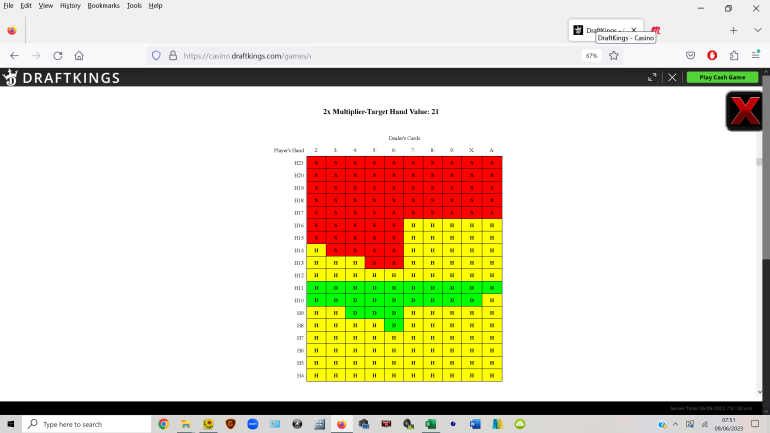
I have agreed to the DK terms of service, so I don't believe I am allowed by the TOS to disseminate screenshots from their games. However, the strategy charts are publicly available to anyone without agreeing to DK's TOS.Quote: charliepatrickI also see that you can surrender (which I had ignored; but I can imagine if the target is, say, less than 16 you might adopt usual rules). Also they have a typo: D* should mean double else stand (e.g. some of the high soft totals).
link to original post
Yes, I noticed the typo in the key to the DK strategy chart. It is a huge mistake in terms of lost EV. I would hope most players would catch on to the mistake quickly, but it confused me at first until I looked at a few situations and realized that the key had to be wrong. Green D should mean 'double else hit', Orange D* should mean 'double else stand'. The error has remained unchanged on the DK strategy charts for many months.
I just want to focus on this one row of your excellent table. It is the only row where C+ appears.Quote: charliepatrickPlease allow for typos and transcription errors but here is a look at when the target is 21 and the correct play for various multipliers 2,5,10,25,50,100. The objective is to show how complicated a correct strategy might be.
S=Stand H=Hit D=Double X=Split (V+)=on 5x or more (X+)=on 10x or more (G+)=on 25x or more (L+)=on 50x or more (C+)=on 100x.
Most decisions stay fixed or flip, but some vary e.g. soft 9 vs A (st, h, d/h, h, h, h).
link to original post
I went through the entire DK strategy and found 204 differences with my strategy out of a total of 22,200 strategy rules. Some of these are close cases where I am looking at the composition of the hand and some of the strategies change with composition. DK lumps all hands with the same total into a single strategy choice, so I necessarily will have a divergence between at least one composition and the DK rules. Most of the divergences are either due to this lumping or else have very small EV deltas.
The DK strategy for playing hard 10 with T=21 is to always double. This results in 21 instances of different strategy between DK and me. That is, (three hand compositions) times (seven hands where I think the hand should be hit). I checked my results against Charlie's table, and I see that he is hitting every hard 10 except against a dealer 6 upcard. I know Charlie is using infinite decks. I reran my calculation with 800 decks, and I agree with your table as you can see below, so the difference is probably infinite decks.
8 decks, S17, DOA, DAS, SPL3, NRSA, surrender, CDZ-
Hard | Dealer's up card
hand | 2 3 4 5 6 7 8 9 10 A
-----------------------------------------------------------
|
8- 2 | H H DH DH DH H H H H H
7- 3 | H H DH DH DH H H H H H
6- 4 | H H DH DH DH H H H H H
|
-----------------------------------------------------------
800 decks, S17, DOA, DAS, SPL3, NRSA, surrender, CDZ-
Hard | Dealer's up card
hand | 2 3 4 5 6 7 8 9 10 A
-----------------------------------------------------------
|
8- 2 | H H H H DH H H H H H
7- 3 | H H H H DH H H H H H
6- 4 | H H H H DH H H H H H
|
-----------------------------------------------------------
M: 100 T: 21 Dealer Up-Card 2 Hand: 6-4
Stand E(X) = -0.290652
Hit E(X) = 13.951661
Double E(X) = 13.891807
M: 100 T: 21 Dealer Up-Card 3 Hand: 6-4
Stand E(X) = -0.247603
Hit E(X) = 14.014603
Double E(X) = 13.995247
M: 100 T: 21 Dealer Up-Card 4 Hand: 6-4
Stand E(X) = -0.204433
Hit E(X) = 14.078410
Double E(X) = 14.102663
M: 100 T: 21 Dealer Up-Card 5 Hand: 6-4
Stand E(X) = -0.159312
Hit E(X) = 14.164917
Double E(X) = 14.231337
M: 100 T: 21 Dealer Up-Card 6 Hand: 6-4
Stand E(X) = -0.151757
Hit E(X) = 14.330139
Double E(X) = 14.431101
M: 100 T: 21 Dealer Up-Card 7 Hand: 6-4
Stand E(X) = -0.475473
Hit E(X) = 14.743035
Double E(X) = 14.619205
M: 100 T: 21 Dealer Up-Card 8 Hand: 6-4
Stand E(X) = -0.513156
Hit E(X) = 14.811438
Double E(X) = 14.566262
M: 100 T: 21 Dealer Up-Card 9 Hand: 6-4
Stand E(X) = -0.543320
Hit E(X) = 14.958761
Double E(X) = 14.552380
M: 100 T: 21 Dealer Up-Card X Hand: 6-4
Stand E(X) = -0.541638
Hit E(X) = 15.397611
Double E(X) = 14.797631
M: 100 T: 21 Dealer Up-Card A Hand: 6-4
Stand E(X) = -0.663394
Hit E(X) = 14.368185
Double E(X) = 13.690309
If you double hard 10, you have roughly one chance in 13 of getting 21. If you draw to hard 10, you either hit your 21 or you always get another 13:1 draw to hit perfectly. If your total is still under 21, you keep hitting. On average, you get to hit 2.18 times, so this is better than hitting one time with a doubled bet.
Asumming you get to 21, this total of 21 has a 88-96% chance of winning against the possible dealer upcards. https://wizardofodds.com/games/blackjack/player-expected-return/ In case of a push, you don't get the 100x multiplier.
On the other hand, if you double, you can still win with less than 21. Hitting either results in a 21 or a bust. This is the reason some of the dealer stiff cards call for a double.
| Double | Stand | Hit | Best | Total | Cards | |
|---|---|---|---|---|---|---|
14.794 553 | -0.539 528 | 15.390 325 | 15.390 325 | H | 10 | 28 |
14.795 169 | -0.538 988 | 15.393 032 | 15.393 032 | H | 10 | 37 |
14.797 631 | -0.541 638 | 15.397 611 | 15.397 611 | H | 10 | 46 |
Also looking at 10 vs 4
(i) Eight Decks
| Double | Stand | Hit | Best | Total | Cards | |
|---|---|---|---|---|---|---|
14.126 954 | -0.209 935 | 14.095 514 | 14.126 954 | Dbl | 10 | 28 |
14.150 851 | -0.205 275 | 14.117 240 | 14.150 851 | Dbl | 10 | 37 |
14.136 003 | -0.204 433 | 14.099 829 | 14.136 003 | Dbl | 10 | 46 |
(ii) 999 decks
| Double | Stand | Hit | Best | Total | Cards | |
|---|---|---|---|---|---|---|
14.005 603 | -0.211 054 | 14.068 298 | 14.068 298 | H | 10 | 28 |
14.005 881 | -0.211 017 | 14.068 654 | 14.068 654 | H | 10 | 37 |
14.005 812 | -0.211 011 | 14.068 642 | 14.068 642 | H | 10 | 46 |
Charlie, Thanks for running the numbers. I have not done much blackjack analysis before. I wanted some confirmation that I did not make substantial logic errors when I modified the code for Bingo Blackjack. I will look at each of the cases you posted and see if I can get good agreement.Quote: charliepatrickI've looked at 8 decks when target=21 multiplier=100 and dealer has 10 (but peeked) and agree.
Double Stand Hit Best Total Cards H H H
Also looking at 10 vs 4
(i) Eight Decks
Double Stand Hit Best Total Cards Dbl Dbl Dbl
(ii) 999 decks
Double Stand Hit Best Total Cards H H H
link to original post
As I mentioned before, the 50x and 100x multipliers are exceedingly rare so this flawed strategy published by DK doesn't matter much. The 25x shows up almost as often as 10x, so minor error at 25x might be more important overall.
None of this gets us any closer to verifying the game RTP. Without the frequencies of multipliers and targets, we just have to accept DK's RTP and hope they did the math right. Given how flawed the strategy table is, I have no confidence in their RTP.
| s11 | AT | St |
| s10 | A9 | H |
| s9 | A8 | H |
| s8 | A7 | H |
| s7 | A6 | H |
| s6 | A5 | H |
| s5 | A4 | H |
| s4 | A3 | H |
| s3 | A2 | H |
| s2 | AA | Spl |
| 21 | 777 | St |
| 20 | TT | Spl |
| 20 | 677 | H |
| 19 | 9T | Dbl |
| 19 | 667 | H |
| 18 | 99 | Spl |
| 18 | 8T | Dbl |
| 18 | 666 | H |
| 17 | 89 | Dbl |
| 17 | 566 | H |
| 16 | 88 | Spl |
| 16 | 79 | Dbl |
| 16 | 556 | H |
| 15 | 78 | Dbl |
| 15 | 555 | H |
| 14 | 77 | Spl |
| 14 | 68 | Dbl |
| 14 | 455 | H |
| 13 | 67 | Dbl |
| 13 | 445 | H |
| 12 | 66 | Spl |
| 12 | 57 | Dbl |
| 12 | 444 | H |
| 11 | 56 | Dbl |
| 11 | 344 | H |
| 10 | 55 | Spl |
| 10 | 46 | H |
| 9 | 45 | H |
| 8 | 44 | Spl |
| 8 | 35 | H |
| 7 | 34 | H |
| 6 | 33 | Spl |
| 6 | 24 | H |
| 5 | 23 | H |
| 4 | 22 | Spl |
49 3T 229 A39 A2T 2227 AA29 AAAT 22225 A2226 AAAA9 222223 A22224 A222222 AA22223 AAA22222 AAAAA2222
Looking at 49 HIT -0.203082 St -0.208489, and 58 Hit -0.209693 ST -0.207596, so it's close but I'm guessing it's because you have an 8.
I found large EV errors for every multiplier, not just 100X. There are glaring errors where you double hard hands totaling 8, but where the target is 21. If you double in this spot, the multiplier is out of play. You would never double a hard 8 unless the target can be hit with one card.
I am not sure if the DK strategy chart included with the pay table is so awful due to gross negligence or due to deliberate introduction of errors to improve the house hold.
I checked the entire strategy space for composition dependence, but I only looked at the subset of hard hands with two cards. This is the complete list of hands where the strategy choice changes from one row to the next with the same hard total. I am only listing the second hand in the sequence. So, if I list the hand as 7-4, then the previous hand was 8-3, etc. The strategy choices are in standard order "23456789XA". Therefore, the strategy change in the first line involves an Ace dealer up card. The "ord: " is just the ordinal number in my full charts.Quote: charliepatrickI've had a quick look at trying to establish whether there are any composition dependemt decisions. Looking at 21x100 vs 10 there don't seem to be. I hope my spreadsheet detects when a Double is changed to a Hit/Stand as it looks at 2-card hands before any 3-card hands.
link to original post
M: 2 T: 12 Strategy: DDDDDDDDDD vs: DDDDDDDDDH 7-4 ord: 10
M: 2 T: 13 Strategy: DDDDDDDDDD vs: DDDDDDDDDH 8-3 ord: 10
M: 2 T: 14 Strategy: DDDDDDDDDD vs: DDDDDDDDDH 7-4 ord: 10
M: 2 T: 14 Strategy: HHHHDHHHHH vs: HHHHHHHHHH 5-3 ord: 13
M: 2 T: 15 Strategy: DDDDDDDDDD vs: DDDDDDDDDH 8-3 ord: 10
M: 2 T: 16 Strategy: DDDDDDDDDD vs: DDDDDDDDDH 6-5 ord: 10
M: 2 T: 18 Strategy: HSSSSHHHHH vs: HHSSSHHHHH 8-5 ord: 8
M: 2 T: 19 Strategy: DDDDDDDDDD vs: DDDDDDDDDH 6-5 ord: 10
M: 2 T: 21 Strategy: SSSSSHHHHH vs: HSSSSHHHHH 9-5 ord: 7
M: 2 T: 21 Strategy: HHSSSHHHHH vs: HHHSSHHHHH 8-5 ord: 8
M: 5 T: 15 Strategy: DDDDDHHHHH vs: DDDDDDHHHH 6-3 ord: 12
M: 5 T: 15 Strategy: DDDDDDHHHH vs: DDDDDHHHHH 5-4 ord: 12
M: 5 T: 19 Strategy: HHHHDHHHHH vs: HHHDDHHHHH 9-3 ord: 9
M: 5 T: 19 Strategy: HHHDDHHHHH vs: HHHHDHHHHH 8-4 ord: 9
M: 5 T: 19 Strategy: HHHHDHHHHH vs: HHHDDHHHHH 7-5 ord: 9
M: 5 T: 20 Strategy: HHHHHHHHHH vs: HHHHDHHHHH 7-6 ord: 8
M: 5 T: 20 Strategy: HHHDDHHHHH vs: HHDDDHHHHH 9-3 ord: 9
M: 5 T: 20 Strategy: HHDDDHHHHH vs: HHHDDHHHHH 7-5 ord: 9
M: 5 T: 21 Strategy: HHHHDHHHHH vs: HHHDDHHHHH 8-5 ord: 8
M: 5 T: 21 Strategy: HHHDDHHHHH vs: HHHHDHHHHH 7-6 ord: 8
M: 10 T: 12 Strategy: HHHDDHHHHH vs: HHHHDHHHHH 4-3 ord: 14
M: 10 T: 14 Strategy: HHHHDHHHHH vs: HHHHHHHHHH 4-3 ord: 14
M: 10 T: 18 Strategy: HDDDDHHHHH vs: HDDDDDHHHH 8-5 ord: 8
M: 10 T: 19 Strategy: DDDDDDDHHH vs: HDDDDDDHHH 8-7 ord: 6
M: 10 T: 19 Strategy: DDDDDDHHHH vs: DDDDDDDHHH 9-5 ord: 7
M: 10 T: 20 Strategy: DDDDDDDDHH vs: DDDDDDDHHH 8-7 ord: 6
M: 10 T: 21 Strategy: DDDDDDDHHH vs: DDDDDDDDHH 8-5 ord: 8
M: 25 T: 14 Strategy: DDDDDDDDHH vs: DDDDDDDHHH 9-3 ord: 9
M: 25 T: 14 Strategy: DDDDDDDHHH vs: DDDDDDDDHH 7-5 ord: 9
M: 25 T: 16 Strategy: DDDDDDHHHH vs: DDDDDDDHHH 9-3 ord: 9
M: 25 T: 17 Strategy: DDDDDDHHHH vs: DDDDDDDHHH 9-7 ord: 5
M: 25 T: 18 Strategy: DDDDDDDDDD vs: DDDDDDDDDH 9-5 ord: 7
M: 25 T: 18 Strategy: DDDDDDDHHH vs: DDDDDDDDDH 8-5 ord: 8
M: 25 T: 18 Strategy: DDDDDDDDHH vs: DDDDDDDHHH 7-6 ord: 8
M: 50 T: 12 Strategy: DDDDDDDHHH vs: DDDDDDHHHH 4-3 ord: 14
M: 50 T: 14 Strategy: DDDDDDDDDH vs: DDDDDDDHHH 5-3 ord: 13
M: 50 T: 16 Strategy: DDDDDDDDDH vs: DDDDDDDDDD 8-4 ord: 9
M: 50 T: 16 Strategy: DDDDDDDDDD vs: DDDDDDDDDH 7-5 ord: 9
M: 50 T: 17 Strategy: DDDDDDDDDD vs: DDDDDDDDDH 7-6 ord: 8
| Tgt=12 | Mult=2 | D=1 |
|---|---|---|
| s11 | AT | St |
| s10 | A9 | St |
| s9 | A8 | St |
| s8 | A7 | H |
| s8 | AA33 | St |
| s7 | A6 | H |
| s6 | A5 | H |
| s5 | A4 | H |
| s4 | A3 | H |
| s3 | A2 | H |
| s2 | AA | Spl |
| 21 | 777 | St |
| 20 | TT | St |
| 19 | 9T | St |
| 18 | 99 | St |
| 17 | 89 | St |
| 16 | 88 | Spl |
| 16 | 79 | H |
| 15 | 78 | H |
| 14 | 77 | H |
| 13 | 67 | H |
| 12 | 66 | H |
| 11 | 56 | Dbl |
| 11 | 47 | H |
| 10 | 55 | H |
| 9 | 45 | H |
| 8 | 44 | H |
| 7 | 34 | H |
| 6 | 33 | H |
| 5 | 23 | H |
| 4 | 22 | H |
M: 2 T: 12 Dealer Up-Card A Hand: 5-6 DK: D opt: D
Stand EV = -0.663164
Hit EV = 0.146433
Double EV = 0.149744
Hard Hand: Delta EV = 0.149744 - 0.149744 = 0.000000
M: 2 T: 12 Dealer Up-Card A Hand: 4-7 DK: D opt: D
Stand EV = -0.664089
Hit EV = 0.146252
Double EV = 0.147440
Hard Hand: Delta EV = 0.147440 - 0.147440 = 0.000000
M: 2 T: 12 Dealer Up-Card A Hand: 3-8 DK: D opt: H
Stand EV = -0.665018
Hit EV = 0.146196
Double EV = 0.145400
Hard Hand: Delta EV = 0.146196 - 0.145400 = 0.000796
M: 2 T: 12 Dealer Up-Card A Hand: 2-9 DK: D opt: H
Stand EV = -0.665913
Hit EV = 0.146106
Double EV = 0.143400
Hard Hand: Delta EV = 0.146106 - 0.143400 = 0.002707
I changed my output to list the lower rank card first to be aligned with the way your program does things. I prefer to list the multiplier first because this is the first ball drawn, then the target ball is drawn.
btw my spreadsheet sorts it by Total, Decision, Number of Cards, a hash value, so I'm only looking for the fact that different hands have different decisions from the previous line. Because of the way the hash is created it usually, but not always, works on the highest card within the hand.
I did notice that the only soft 18 hand that you stood on was AA33.
My problem isn't the fine details of the strategy. My problem is that I cannot seem to ever win with made target totals. I dropped another $6500 yesterday on just 137 hands. I had a nightmare sequence where I hit four target totals against a dealer stiff up card. There were two 2x and two 5x multipliers. The dealer turned a stiff into a 21 on each of the four hands! Within this stretch, I made a low target on a 5x multiplier against a dealer 10. That hand, I won when the dealer busted. That was my only winning multiplier above 2x in the whole session. I am already down six figures on Bingo Blackjack, but I got a fraction of this back on loss rebates and play-to-earn promos. The DK promo page says someone won $52K on a hand of Bingo Blackjack, but it wasn't me.Quote: charliepatrickFor 4/7 I get Dbl=145363 HIT=145575; for 5/6 I get DBL=147669 Hit=145756 (I agree with the stands as obviously the player doesn't take any further cards). I suspect the difference is because the chances of a 10 are slightly more once the Dealer has peeked (and not got one), but would have expected this means it's better to double. (So I might have to check my peeking logic for Aces.)
btw my spreadsheet sorts it by Total, Decision, Number of Cards, a hash value, so I'm only looking for the fact that different hands have different decisions from the previous line. Because of the way the hash is created it usually, but not always, works on the highest card within the hand.
I did notice that the only soft 18 hand that you stood on was AA33.
link to original post
Correct strategy calls for splitting a large percentage of hands including many X-X hands that are never split for normal BJ basic strategy. Here are the percentages of starting hands that ended up with N hands due to splitting:
| # Hands | Percentage | 4 | 0.48% |
|---|---|
| 3 | 0.62% |
| 2 | 3.71% |
| 1 | 95.18% |
I have never won a hand with a 50x or 100x bingo multiplier. These should be exceedingly rare events. If I ever do get one, I hope it is on a doubled hand or dealt blackjack. I have landed seven 25x multipliers, and one of them was doubled.
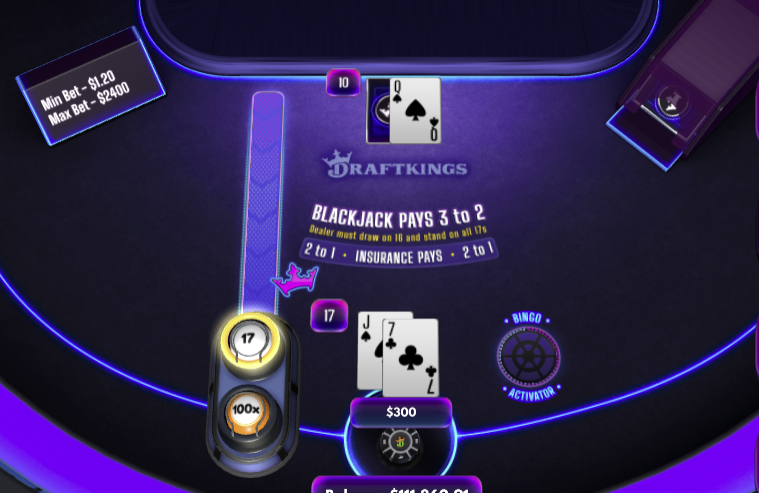
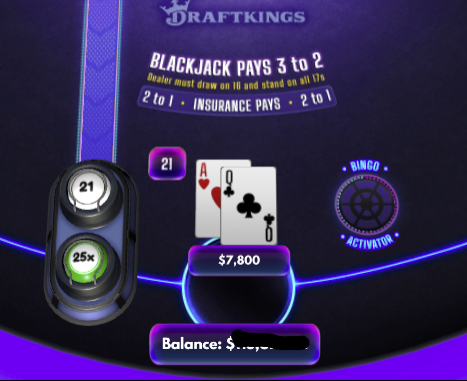
Do you believe this game is gaffed/insincere/corrupt?
I had an horrible year last year. This is the third 25x target that I won with this year and I feel I am ahead on the game for 2024. I don't play enough hands to be in the long run yet or even the middle run.Quote: gordonm888Are you still running at a low ROI on this game?
Do you believe this game is gaffed/insincere/corrupt?
link to original post
Most of the targets are 16 and lower. It is easy to hit a 25x 13 target and lose the hand. You have to double and split and resplit insanely often. For a 25x and a 21 target, you double every hand up to 19 and split TT expecting to double or resplit every hand where you don't catch an Ace. The 20% premium is a killer even when you are pushing a lot of hands and winning your fair share.
The variance of the game is around 4 or 5.
I record every single multiplier and target into a file while I am playing. The recording program indexes me to the right strategy chart for that specific hand. I know many of the right plays, but there are hundreds of close cases. I glance at a strategy chart before I play most hands just to be sure I am not blundering.
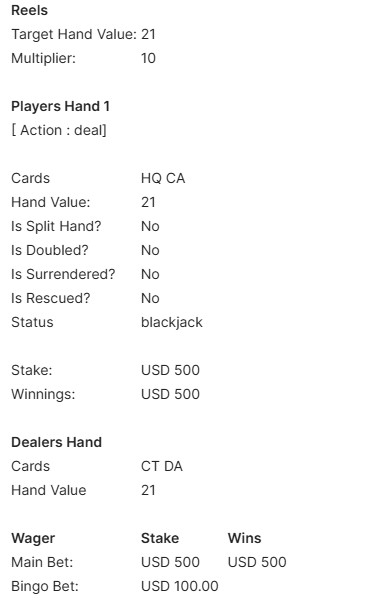
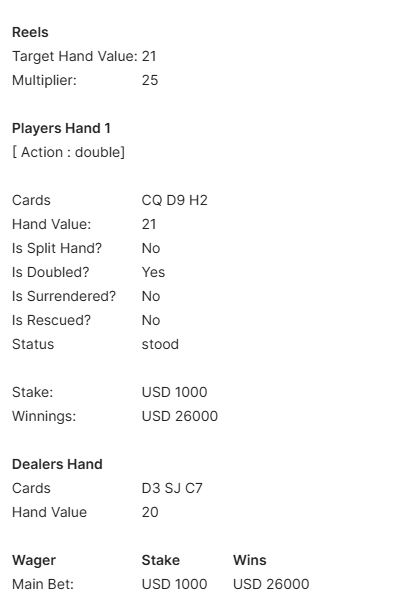
I was kind of shocked when I pulled the deuce of hearts for a total of 21. The dealer had a chance to match my 21 and turn my miracle hand into a loser. Dealer fell one short with a total of 20.
This year, I started having winning sessions at slots and Bingo Blackjack. I caught my second 25x double down winner within a week. I managed to snap a screenshot before it vanished. The dealer's hand vanished, but it was an 8 up and the dealer made a 17.
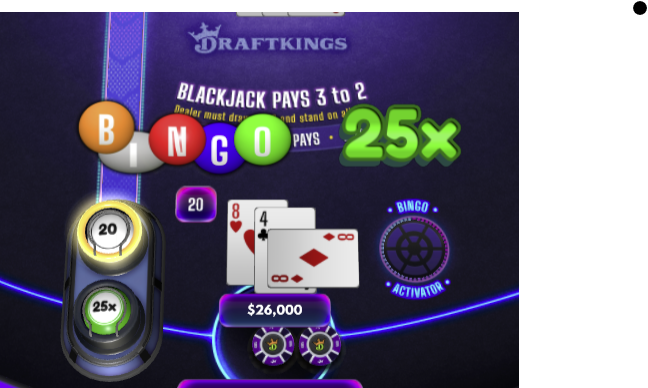
I would have doubled any total between 10 and 19 against any dealer card, and I would have doubled a total of 9 versus dealer 2-8.
Nothing beats doubling a stiff hand into a dealer 8 and winning.
Lately, I have been running poorly at slots and running especially bad at Bingo Blackjack. I lost $90K in the last three weeks, including $40K on BBJ in the last three sessions.
I did manage to split 66 to four hands twice in a month:
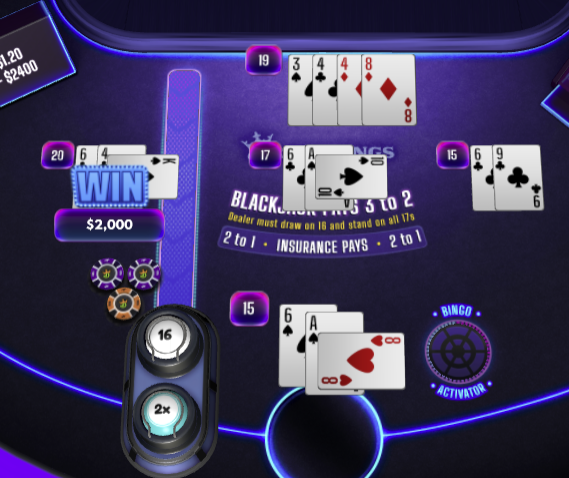
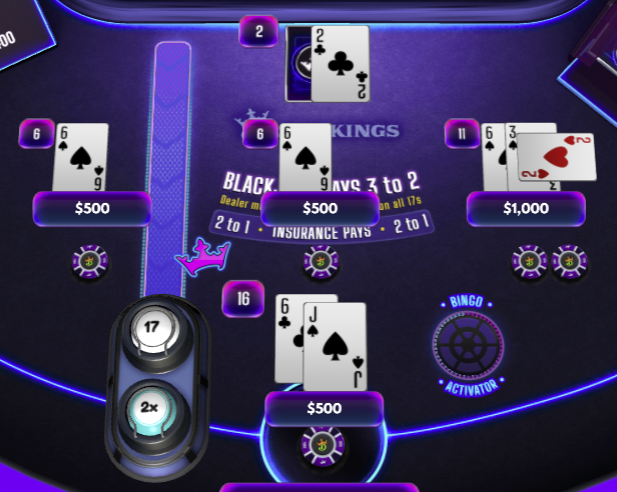
The dealer busted on the second one, and I had ended my play with 6 bets out and no hand over a total of 16.
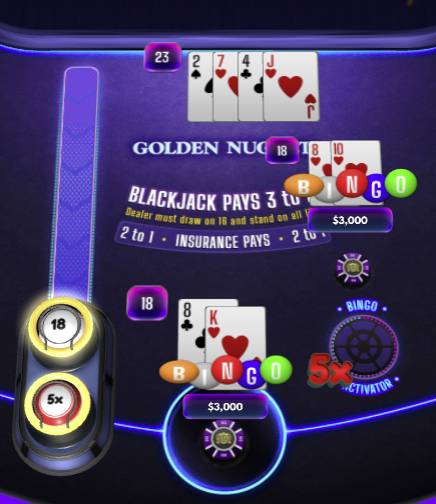
Sometimes splitting eights works out.
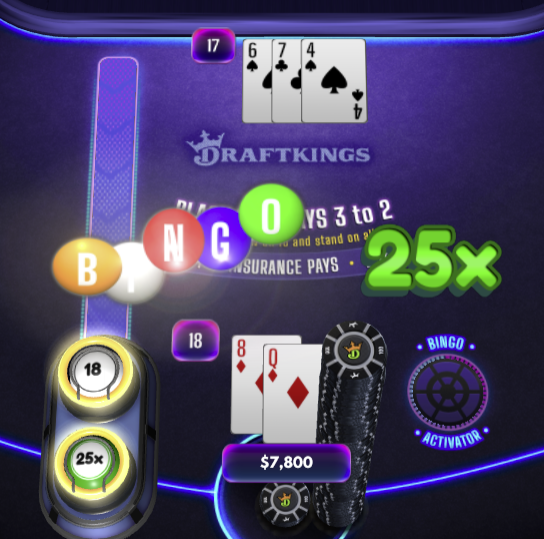
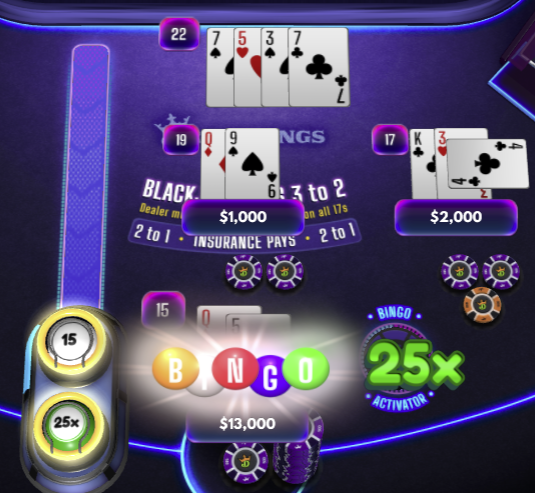
I needed to catch a few breaks. I started September by losing $93,000 over four days on slots and BJ. I won $34K of it back since then, plus I earned $19K of free slot play through the 9th.
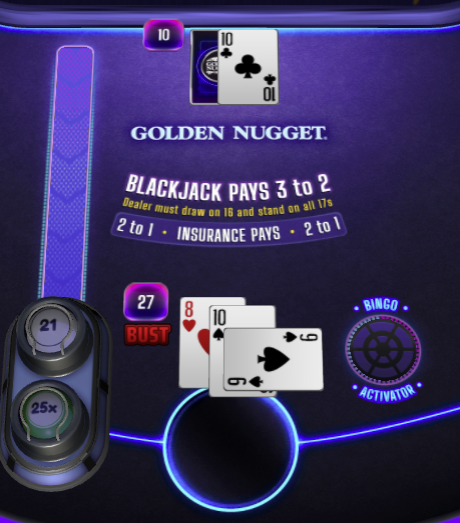
This is what usually happens when you have a 25x multiplier. You have to double into a strong dealer up card. I did it again a few minutes later.
